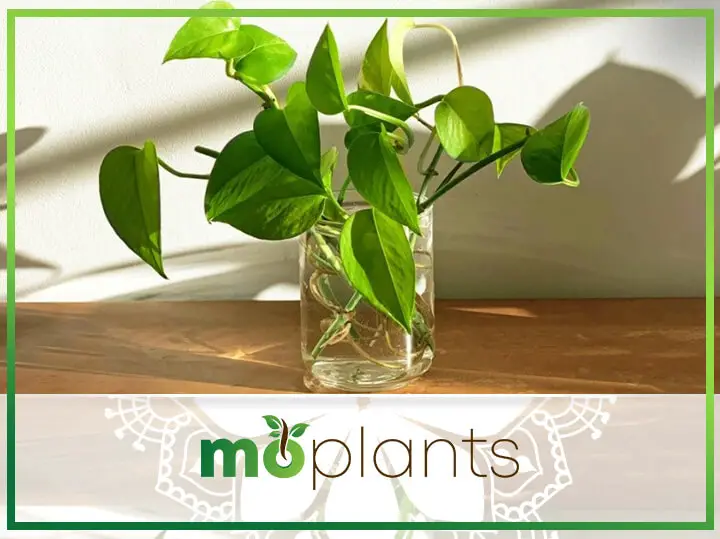The lush foliage, undemanding nature and air purifying properties of golden pothos make it one of the best plants to grow indoors. Although most people tend to overlook these vines favouring fancier houseplants, pathos is arguably the easiest to nurture. It thrives on indirect light, doesn’t require much water and is rather forgiving of neglect.
Being a tropical vine, pothos grows at a moderate to fast pace. In their natural habitat, these vines can climb trees and can grow up to 60 feet. However, in an average home environment, they can trail between 6 and 10 feet.
Since it can grow around various surfaces, remains green in darkness and is almost impossible to kill, pothos is also called devil’s ivy. So even if you don’t have a green thumb, you can easily keep these lovely houseplants alive for years.
Introduction: Golden Pothos

The botanical name of pothos is Epipremnum aureum. However, it is more commonly referred to as devil’s vine, taro vine, Ceylon creeper, silver vine and Solomon Islands ivy. This plant is native to the tropical regions in the Western Pacific islands and Southeast Asia, so it flourishes in places that don’t receive direct sunlight.
Although pothos requires bright but indirect light to grow, it is also tolerant of fluorescent lighting. This is among the main reasons you are likely to find these beautiful vines cascading down their planters and climbing up totems in most corporate offices and dorm rooms. Direct exposure to sunlight, on the other hand, can result in the foliage losing its color.
The most distinctive feature of golden pothos is its heart-shaped leaves that are wide, textured and thick. These variegated leaves are approximately 4 to 12 inches long and grow on thin and flexible stems. Most pothos plants are green or chartreuse in color, featuring white, yellow, and light green striations.
In their native habitat, some mature vines may occasionally sprout small white flowers. However, pothos doesn’t bloom when grown indoors.
Furthermore, these houseplants have incredible air purifying properties. They can remove toxins such as formaldehyde, benzene and carbon monoxide from your home environment, improving indoor air quality. Pothos also helps eliminate odors, leaving your home or office smelling fresh and clean.
How to Grow Golden Pothos Indoors
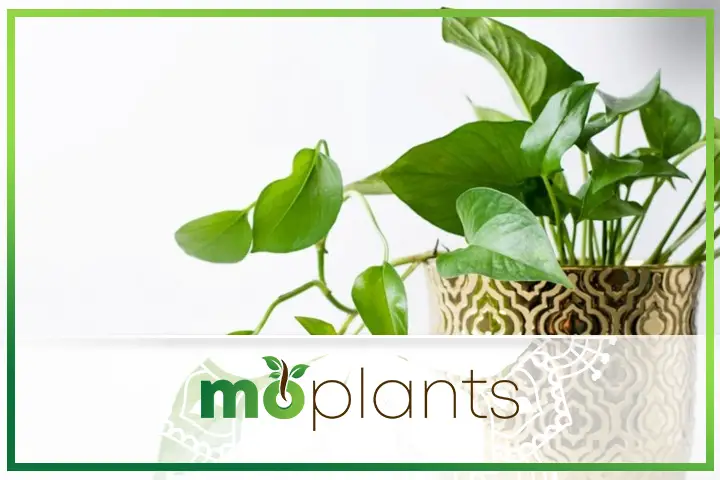
You don’t have to be an expert to be able to grow golden pothos successfully. This tropical vine basically grows itself, as it requires minimal upkeep and care.
However, if you are planning to add this beautiful plant to your home, here are a few things you should know about it.
Best Placement
You should place this plant near a window that receives indirect sunlight. The spot shouldn’t be too dark or receive cold drafts.
Ideal Temperature
For golden pothos to flourish, the temperature should ideally be between 60 and 80 degrees Fahrenheit.
Humidity Level
Pothos thrive in high humidity. You can easily place them in your bathroom or kitchen as they are usually the most humid rooms in any home. These plants are also tolerant of dry weather, though you can consider investing in a room humidifier to keep the foliage healthy during the winter months.
Type of Soil
You can plant golden pothos in any high-quality and well-draining potting soil. It would be even better if the soil is slightly acidic with a pH of 6.1 to 6.5.
Exposure to Sunlight
Pothos prefers indirect light. If you leave it out in the sun for a longer duration, the leaves will start losing their color.
Watering Frequency
Pothos must only be watered when the top inch of the soil gets completely dry. Continuously watering the plant will keep the soil damp, resulting in root rot.
Pot Size
There are no such specifications for pothos pots, except that they should have enough drainage holes. The pot should also be at least two-inch wider than the actual root ball.
Propagation
You can easily propagate pothos through division.
For golden pothos propagation, cut 6-inch-long trails and place them in a jar of water. It will take about 2 to 3 weeks for the roots to develop, after which you can place them in a new pot. You can even grow multiple stems in a single pot, as it will result in a bushier plant.
Golden Pothos Care Tips
Golden pothos is tolerant of almost every home environment, which makes caring for them even easier.
Here are some golden pothos care tips that can help keep your houseplants in good shape.
Discarding Excess Water
Does the pot of your golden pothos plant have a small saucer underneath? Whenever you water the plant, remember to throw away the excess water accumulated in the saucer placed under the pot. This practice will keep the pothos roots healthy and prevent them from rot.
Balanced Fertilizing
Pothos are not heavy feeders. However, to ensure the soil has enough nutrients, you can feed these houseplants a balanced fertilizer every two to three months. It will keep them nourished and strong.
Trimming and Pruning
These tropical ivies can grow in whichever direction they please. You can either trim the trail for a compact appearance or allow the plant to grow and expand as per your preference. Just make sure to snip the bare stems as soon as you spot them to promote the growth of new branches.
Wiping and Cleaning
You can wipe the leaves of golden pothos plants with a damp cloth every couple of weeks. This way, you can keep your plant looking fresh and shiny.
Repotting
If the plant begins to droop regardless of being watered regularly, it means the roots don’t have enough room to grow. Once that happens, you should consider repotting pothos into a bigger vessel.
Infographic
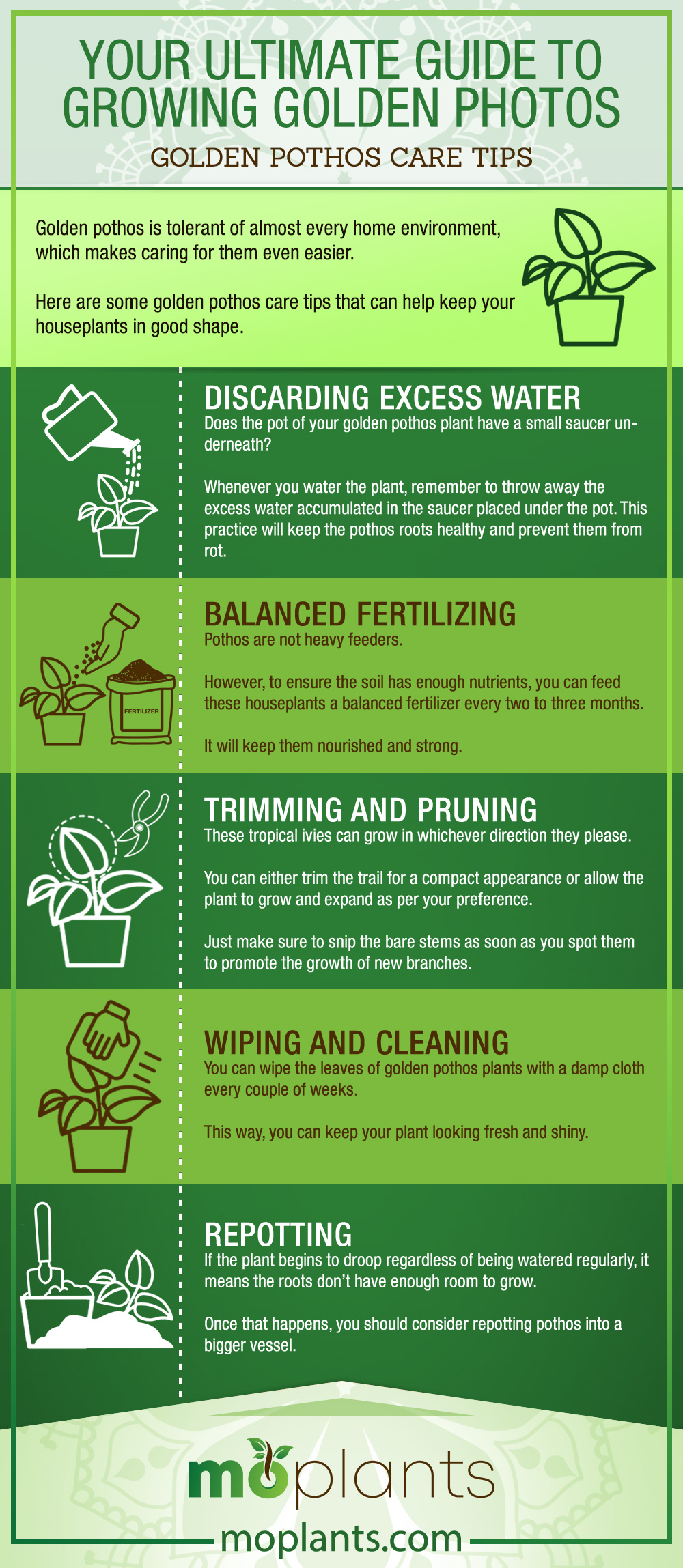
Common Pothos Problems and How to Solve Them

These are some of the most common problems you may face while growing golden pothos indoors, along with their solutions.
Brown and Yellow Leaves
Brown and yellow leaves usually indicate the plant isn’t receiving enough water. To troubleshoot this problem, you can start watering the plant more frequently for healthier foliage.
Meanwhile, if the leaves appear pale brown, it may be a sign that your plant is receiving too much direct sunlight. In such a case, moving the pot to a darker and more humid area can help significantly.
Loss of Color
If your golden pothos plant leaves start to lose their color, you should move them to a brighter location. Pale leaves are usually an indication that the plant is not receiving enough light.
Blackened leaves and stems
Black leaves and stems are a sign of root rot. This mostly happens when the plant is being overwatered.
The easiest way to deal with this is to trim the affected branches and move the plant to a warmer area. Also, allow the soil to get completely dry will promote new growth.
Pest Infestation
Pothos are virtually pest and disease-free. However, in some cases, they can be infested by mealy bugs.
If that happens, dip a cotton ball into 70% rubbing alcohol and wipe the affected areas. You can also use insecticidal soap for this purpose.
Is Golden Pothos Poisonous?
Though it may appear completely harmless, golden pothos is toxic to cats and dogs. It also must be kept away from children’s reach. While the poisoning from this tropical ivy is rarely fatal, it can still result in mild irritation if ingested. The insoluble calcium oxalate crystals in pothos can trigger a painful reaction once it comes in contact with moisture from the mouth.
Symptoms of GoldenPothos Poisoning
These are some of the most common symptoms of pothos poisoning:
- Oral irritation
- Eye irritation
- Swollen tongue
- Difficulty swallowing
- Vomiting
- Trouble breathing
- Foaming at the mouth
If you notice your pets exhibiting any of these symptoms, please contact your vet as soon as possible.
Different Varieties of Pothos
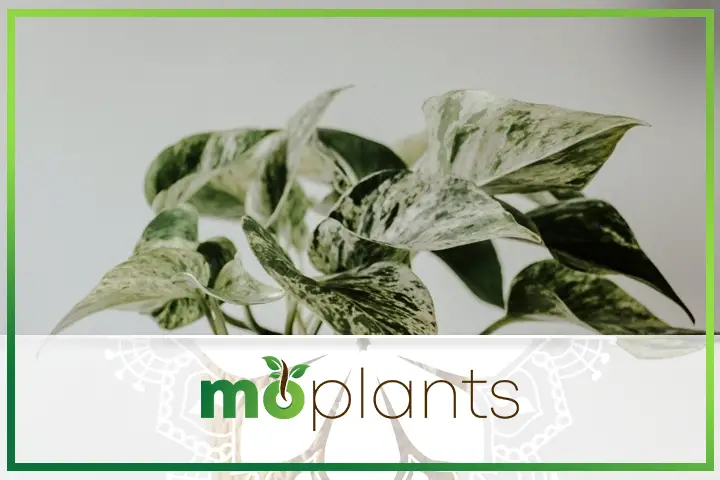
Pothos has many varieties based on leaf variegation. Some of the most popular ones include:
Marble Queen
Marble Queen has heart-shaped green leaves with splashes of yellow and white colors. It is similar in appearance to golden pothos but requires more light to keep the foliage healthy.
Jessenia Pothos
Jessenia Pothos tend to grow a little slower compared to golden pothos. However, it also has dark green leaves splashed with lime-green spots and freckles.
Neon Pothos
Unlike other pothos varieties, the heart-shaped leaves of neon pothos have no variegation. The foliage is golden yellow or chartreuse, with the newer leaves being much brighter than, the older ones. This plant flourishes in areas that don’t receive a lot of sunlight.
Cebu Blue Pothos
The gorgeous Cebu blue pothos doesn’t have any striations on its foliage. Instead, the arrow-shaped leaves of this plant blend blue and green hues with a little metallic sheen. As the leaves mature, they can become larger with natural splits.
Pearls and Jade Pothos
This variety of pothos features green leaves with white, grey and silver variegation dotting the edges. Peals and Jade are among the most striking pothos varieties. They also have smaller leaves and usually grow at a slow pace.
How to Display Golden Pothos Indoors
Pothos plants can brighten up any room they are placed in. Whether you want to add some greenery to your living room or are looking to add a splash of color to your office, growing these tropical vines is perhaps your best option.
There are several different ways you can choose to display golden pothos plants indoors.
Totems or Moss Poles
Unlike most other varieties of ivy, pothos plants do not adhere to other objects for support unless trained. Therefore, if you want to let your houseplant trail longer, consider using a totem or any other vertical support and train the vines around it. Doing so will keep your plant looking healthy and well-kept.
Moreover, if you let the trails grow longer without placing them around vertical support, they can get very tangled and appear dishevelled.
Hanging Baskets
If you want to opt for a more sophisticated display, consider placing your golden pothos plants in a hanging basket. This will allow the vines to cascade down and make it easier for you to prune.
Cup Hooks
Allowing pothos to grow horizontally across bookshelves and tabletops can add to the aesthetics of your space. You can also train these vines to grow along with the window or door frame. Furthermore, cup hooks and s-hooks are a great way to support the longer tendrils without making them look messy.
Decorative Pots
Small decorative pots are perfect for bushy plants with short trails. You can use them to decorate your workstation, nightstands and coffee tables. If you are worried about constantly pruning the plant, consider growing a pothos variety with a slower growth rate.
Pothos varieties that prefer low lights can flourish in office spaces, dorm rooms, and dark corners of your home. Since this plant is also excellent at removing toxins from the air, you can also place it in your garage.
Infographic
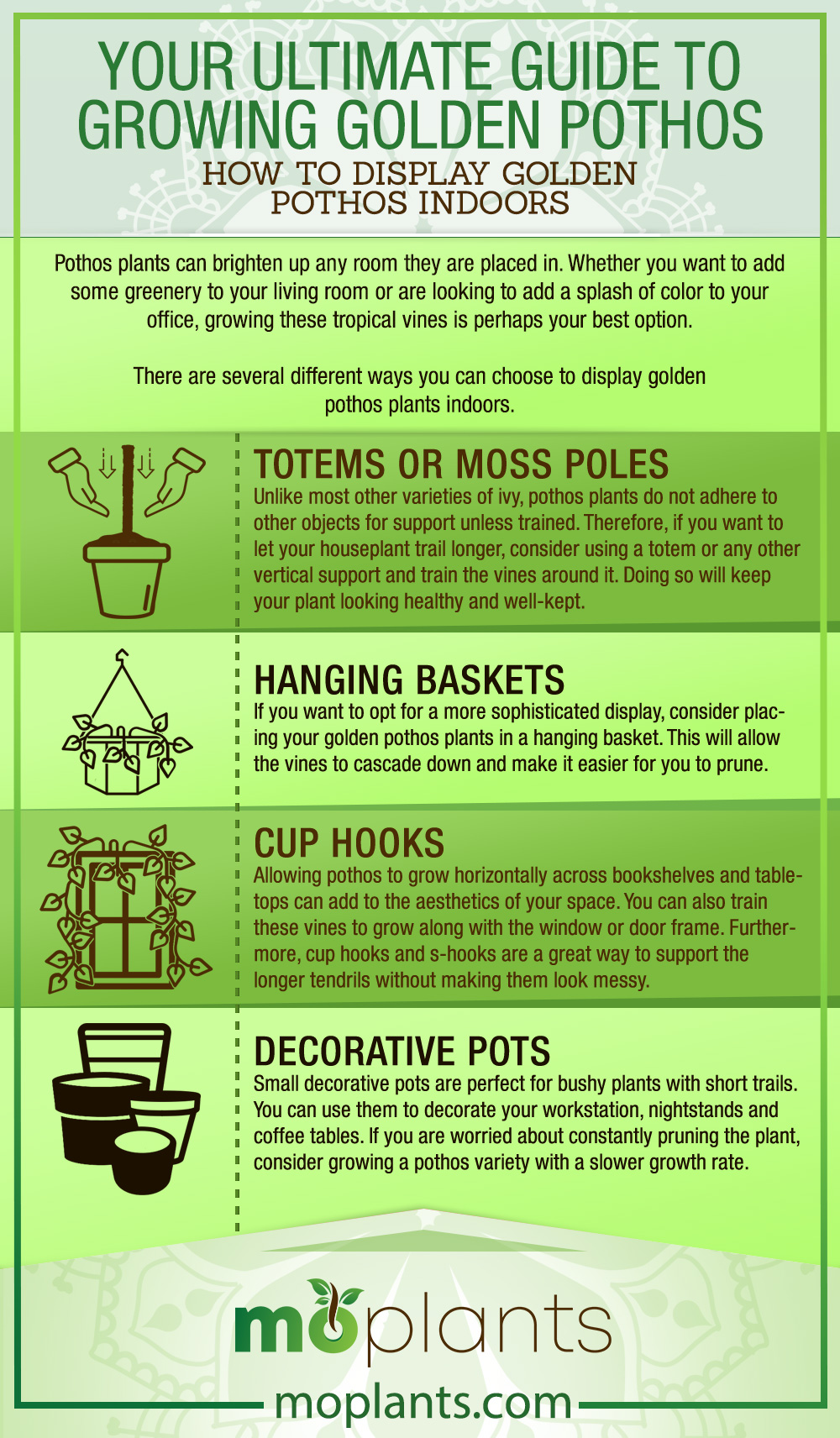
Golden Pothos FAQs
Here are some of the most frequently asked questions about golden pothos.
How often should you water pothos?
Ideally, it would help if you watered them once a week. However, if you live in a warm region or if your plant is placed in a spot that receives bright light, you can water it more frequently.
Can you plant pothos cuttings directly into the soil?
For golden pothos propagation, put the freshly cut trails into a jar of water. Once the roots begin to appear, you can plant them into a pot and place them in a spot that receives indirect light.
How long can a golden pothos plant survive indoors?
Depending on how well you take care of it, pothos can survive up to 10 years. However, factors such as the environment, rotten roots, mealy bugs, and exposure to direct sunlight can affect its lifespan.
So, as long as you follow the basic golden pothos care tips, your plant will continue to flourish and liven up your home.

